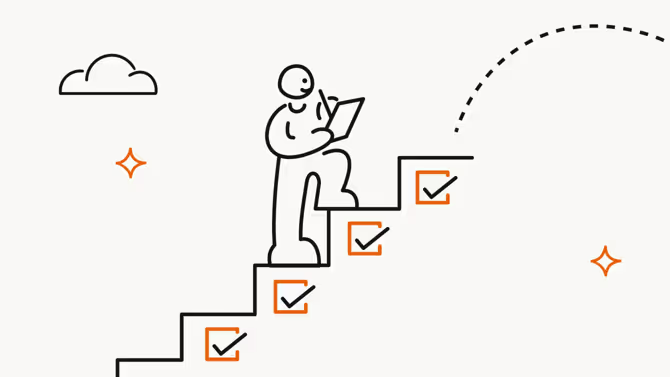Automating onboarding: How to scale your onboarding process

Streamline, organize, and automate your onboarding process like magic.

Onboarding sets the tone for a new employee’s entire experience at your company. But for at least one in four employees, that tone isn’t positive. And their disappointment has real consequences for the company, from lower engagement to early turnover and steep replacement costs.
Savvy HR teams are automating onboarding workflows to fix what’s broken. By shifting from manual tasks to smart, streamlined systems, they’re creating a more consistent and welcoming experience.
Read on to learn how to automate your workflows with onboarding automation without losing the human touch.
What is onboarding automation?
When HR handles everything manually, there’s rarely enough time to create a personalized onboarding experience. And when things get rushed, mistakes can easily slip through, hurting both the new hire and the business.
Onboarding automation replaces manual tasks and messy spreadsheets with streamlined, software-driven workflows. The right software standardizes the onboarding experience, freeing up HR teams to focus on people instead of paperwork. It can even generate an automated onboarding checklist tailored to each new employee.
Here’s what automating your onboarding processes helps you do:
- Scale: Automation eliminates repetitive tasks so HR can handle 50 new hires as easily as five.
- Standardize: With onboarding automation, every new hire gets the same core experience, even as workflows adapt based on role, department, or location.
- Measure: By tracking key onboarding metrics like time-to-hire and early turnover, HR can improve outcomes with data, not guesswork.
- Personalize: Contrary to popular belief, automation improves connection, letting HR spend more time with people and less on administrative tasks.
How to automate employee onboarding in 3 steps
Thanks to purpose-built software solutions like Workleap Onboarding, integrating automation in your onboarding workflows is straightforward. Here’s a step-by-step guide.
1. Identify your objectives
Onboarding initiatives work best when you clearly define their intended outcomes. And the more specific those objectives, the better. Instead of broad goals like “speed up onboarding,” aim to “have every new hire sign paperwork and set up accounts before day one.”
It’s easier to pinpoint high-value objectives if you examine your current onboarding bottlenecks. There are three ways to do this:
- Go through your available onboarding analytics, including HRIS and LMS data. These records can highlight areas where HR or new hires face friction.
- Talk to HR about their experiences bringing on new employees. What do they say works or doesn’t work, and what needs to change?
- Speak with new hires to hear how the process went. Holding face-to-face 1:1s works well, but quick pulse surveys are just as effective.
2. Define what success looks like
Once you’ve defined your objectives, be specific about what success looks like for each. Consider pairing each goal with a metric or checklist item to track progress clearly.
Here’s how to turn goals into measurable success criteria:


Clear metrics like these help you track what’s working and guide resource allocation decisions. They also demonstrate the impact of automating onboarding processes to leadership, helping secure buy-in and future investment in HR tools.
3. Find the platform that meets your needs
Once you’ve defined your objectives and success metrics, it’s time to decide on an automation platform. Look for a solution that supports the workflows you’ve mapped and tracks the outcomes you care about. You can also explore automation features in the HR tools you already use.
Here’s what to prioritize in a new onboarding automation platform:
- Reputation: Look for verified reviews from companies like yours. Real-world feedback is often more reliable than marketing claims.
- Total cost: Go beyond upfront pricing. Ask about implementation, training, and ongoing maintenance to understand the total cost of ownership.
- Ease of use: Automation doesn’t need to be complicated. The more intuitive the platform, the faster your team will adopt it (and the faster you'll see results).
- Compatibility: Seamless integration speeds up rollout and scalability, so make sure the platform integrates with your HRIS and other tools.
- Security: A security breach will cost far more than any time saved. Look for a platform that meets your industry's compliance standards and offers features like data encryption and role-based access controls.
Some solutions focus on a specific onboarding automation function, like MDM. Others, like Workleap Onboarding, take a more holistic approach. Workleap automates the entire onboarding lifecycle, from generating personalized, role-specific plans with AI tracking progress to surfacing actionable insights. It’s designed to streamline onboarding at every step, helping HR teams deliver a consistent, engaging experience for new hires.
With clear goals, success metrics, and the right platform in place, automating onboarding processes becomes a low‑risk, high‑reward initiative. Start small, measure consistently, and scale what works.
How to strengthen human connection with onboarding automation
Businesses often worry that automated employee onboarding processes feel cold or impersonal. In reality, they do the opposite.
By automating repetitive logistics, HR and managers gain more time to focus on people, not paperwork. With the right tools, you can design thoughtful, personalized moments that make new hires feel seen and supported from day one.
Here’s how to use automation to enhance connection throughout the onboarding journey.
Send a digital welcome packet
A well-timed welcome packet helps new employees feel confident and cared for before they even start. They typically include essential resources, company policies, and team introductions. With automation, HR can:
- Tailor packets by role, location, and seniority
- Schedule delivery at the right time, like after contract signing or a week before the new hire’s start date
- Track engagement, sending reminders when needed
Auto-build role-specific onboarding schedules
Automated scheduling helps HR deliver consistent, tailored onboarding experiences without the manual effort. With the right platform, you can:
- Generate personalized, AI-driven onboarding schedules from smart templates
- Auto-sync onboarding events with new hires’, managers’, and trainers’ calendars
- Flag key milestones, like first-week check-ins or probation reviews, and send automatic reminders to everyone involved
Match each new hire with a buddy
Buddy systems help new hires ease in, adapt to company culture, build connections, and become productive sooner. HR can use automation to instantly:
- Pair every new hire with a compatible buddy based on role, timezone, or shared interests
- Schedule their first (and follow-up) check-ins — the more check-ins, the better
- Send reminders to keep the relationship active throughout the new employee’s first months
Remind managers to check in with new hires
Regular check-ins from managers help new employees feel valued and supported, but they’re easy to overlook. Automation helps you build these moments into the flow, letting you:
- Schedule automatic reminders for initial meetings and regular follow-ups
- Provide structured conversation prompts to guide meaningful discussions
- Track meeting completion to make sure no one falls through the cracks
Trigger quick pulse surveys
Pulse surveys give HR real-time insight into how new hires feel about their onboarding. Because they’re lightweight and timely, these surveys make it easy to spot bottlenecks early, and, just as importantly, to celebrate wins.
Automation makes gathering and acting on feedback easy, allowing you to:
- Deliver short, targeted pulse surveys at key onboarding milestones
- Let new hires respond anonymously or by name according to their comfort level
- Consolidate insights in a centralized dashboard and alert key stakeholders when they need to take action
Send company swag
Company swag is a small gesture with a big emotional impact. It signals belonging from day one. Automation simplifies swag logistics without removing the human touch. With the right setup, you can:
- Auto-ship swag so it arrives on or before the new hire’s first day
- Customize items by role, team, or location
- Track deliveries and prompt managers to follow up with a personal note
Celebrate milestones
The early days of a new role can fly by. But they’re packed with growth, progress, and performance wins worth celebrating. Pausing to recognize progress helps new employees feel appreciated, strengthens team bonds, and builds positive momentum. By automating recognition systems, you can:
- Schedule milestone announcements (personal, team-wide, or company-wide) and personalized congratulations messages
- Prompt managers with timely reminders to acknowledge progress
- Track recognition activities to ensure consistent engagement across teams
Automate your onboarding processes with Workleap Onboarding
When new employee onboarding runs smoothly, your entire organization benefits. New hires ramp up faster, team members feel more connected, and HR can focus on people instead of processes.
With Workleap Onboarding, human resources teams can streamline the entire experience using automated workflows that drive real impact. From welcome packets and role-based scheduling to manager check-ins and milestone celebrations, Workleap makes it easy to create a thoughtful onboarding journey.
Workleap is making work simpler, kinder, and faster.


%20(1).avif)


.avif)
.avif)







